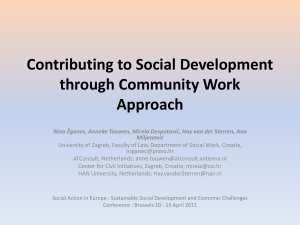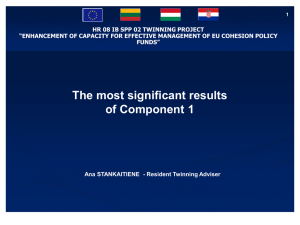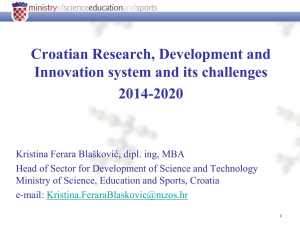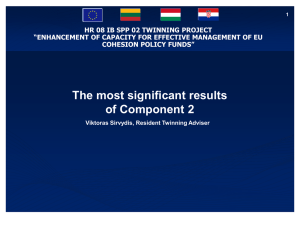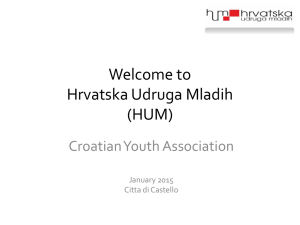Presentation
advertisement
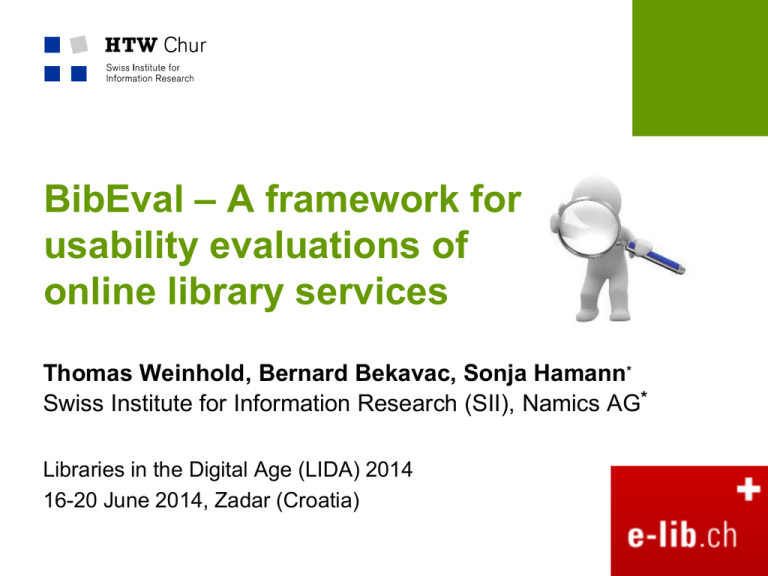
BibEval – A framework for usability evaluations of online library services Thomas Weinhold, Bernard Bekavac, Sonja Hamann* Swiss Institute for Information Research (SII), Namics AG* Libraries in the Digital Age (LIDA) 2014 16-20 June 2014, Zadar (Croatia) e-lib.ch – Swiss electronic library Innovation and cooperation initiative with 20 sub-projects Vision: creation of a national portal to improve access and retrieval of scientific information (www.e-lib.ch) e-rara.ch Marketing e-lib.ch DOI desk Kartenportal.ch Web portal e-lib.ch Metadata servers swissbib Best-Practices E-Depot Basel Infoclio.ch Bern retro.seals.ch Long-term preservation Zürich e-codices Fribourg Infonet Economy Genève ACCEPT RODIN ElibEval Chur Information literacy Martigny Search skills Multivio LIDA 2014, 16-20 June 2014, Zadar (Croatia) Seite 2 Sub-project "ElibEval" Usability evaluations of web sites and applications developed in the context of e-lib.ch Conception and creation of analytical tools to support information providers in carrying out their own evaluations LIDA 2014, 16-20 June 2014, Zadar (Croatia) Seite 3 Situation of libraries Changes in environment and increasing competition Mission: "[..] encourage the library and information sector to work with partners and users to maximize the potential of digital technology to deliver services that enable seamless and open access by users to cultural and information resources." (IFLA Strategic Plan 2010-15, http://www.ifla.org/files/hq/gb/strategic-plan/2010-2015.pdf) Offer the same ease of use, robustness and performance as internet search engines combined with the quality, trust and relevance traditionally associated with libraries LIDA 2014, 16-20 June 2014, Zadar (Croatia) Page 4 Challenges for libraries Libraries Physical collection Databases Presentation Digital collection Website Support Indexing Library catalogue Archiving Additional information Management Merging of heterogeneous information Organizing interaction of various systems, so that users can pursue their objectives without hindrance ("don't burden users with library-interna") LIDA 2014, 16-20 June 2014, Zadar (Croatia) Seite 5 User-perceived quality of library online services (Tsakonas & Papatheodorou, 2006) “The extent to which a product can be used by specified users to achieve specified goals with effectiveness, efficiency and satisfaction in a specified context of use.” (ISO 9241-Part 11: Guidance on usability) LIDA 2014, 16-20 June 2014, Zadar (Croatia) Page 6 Usability evaluation methods Two main criteria to categorize usability evaluation methods: When (formative vs. summative evaluation) Who (user-oriented/empirical vs. expert-oriented/analytical methods) LIDA 2014, 16-20 June 2014, Zadar (Croatia) Page 7 Usability evaluation of online library services As in our own project, libraries generally use a wide spectrum of methods for usability evaluations Kupersmith (2012) provides a good overview According to this literature review the most commonly used method is user observation / usability tests Observation of real user behaviour Time-consuming and expensive Heuristic evaluation is a widely used instrument (cheaper, quicker) LIDA 2014, 16-20 June 2014, Zadar (Croatia) Page 8 Heuristic evaluation Experts examine whether an interface is compliant with established usability principles (the "heuristics") Nielsen's heuristics (1994): 1. Visibility of system status 6. Recognition rather than recall 2. Match between system and real world 7. Flexibility and efficiency of use 3. User control and freedom 8. Aesthetic and minimalist design 4. Consistency and standards 9. Help users recognize, diagnose and recover from errors 5. Error prevention 10.Help and documentation (http://www.nngroup.com/articles/ten-usability-heuristics/) LIDA 2014, 16-20 June 2014, Zadar (Croatia) Page 9 Motivation for the development of library specific heuristics Most studies limit themselves to common heuristics, e.g. Nielsen’s 10 heuristics Lack of library specific recommendations (e.g. Clyde 1996, Clausen 1999, Raward 2001) Problems of common heuristics: too generic for an in-depth analysis extensive knowledge in the field of user interface design is needed Our Goal: Develop more detailed heuristics, which are suited to the specific requirements of library websites are easy to use and allow a judgement even to non-experts assist developers in building user-friendly library websites LIDA 2014, 16-20 June 2014, Zadar (Croatia) Page 10 Methodical approach Three cornerstones: literature review “usability evaluations in libraries” best-practice-analysis of library websites focus group (to discuss and further refine our concept) Result: modular, hierarchically structured list of evaluation criteria all website elements and evaluation criteria classified into mandatory and optional This concept aims at maximizing the applicability of the heuristics for libraries of different size and type. LIDA 2014, 16-20 June 2014, Zadar (Croatia) Page 11 BibEval – Structure 4 sectors divided into sub sectors Different components in each sub sector Questions/evaluation criteria for each hierarchy level information & communication search & explore the collection(s) personalization & customization user participation search Suchen&& exploration Erkunden simple search advanced search presentation & access LIDA 2014, 16-20 June 2014, Zadar (Croatia) 12 Usage of BibEval – Selection of sectors and components http://www.cheval-lab.ch/en/usability-of-library-onlineservices/criteria-catalogue-bibeval/ LIDA 2014, 16-20 June 2014, Zadar (Croatia) Seite 13 BibEval – Severity rating and comments LIDA 2014, 16-20 June 2014, Zadar (Croatia) Seite 14 BibEval – Reports / Export functions LIDA 2014, 16-20 June 2014, Zadar (Croatia) Seite 15 BIBEVAL – PROJECT ADMINISTRATION LIDA 2014, 16-20 June 2014, Zadar (Croatia) Seite 16 Project Administration LIDA 2014, 16-20 June 2014, Zadar (Croatia) Seite 17 Conclusions and further work One criticism levelled against heuristic evaluation: in-depth knowledge of HCI is required in order to apply this method correctly (Blandford et al. 2007; Warren 2001) In formulating our evaluation criteria, we focused on end-user perspectives Enable libraries to conduct self-evaluations Continuous improvement of our criteria catalog to keep it up to date Extension of our web application (e.g. deleting questions, add own criteria) Further development through community LIDA 2014, 16-20 June 2014, Zadar (Croatia) Page 18 Your Questions? thomas.weinhold@htwchur.ch bernard.bekavac@htwchur.ch sonja.hamann@namics.com http://www.cheval-lab.ch http://www.e-lib.ch

